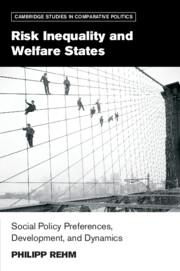Book contents
- Frontmatter
- Dedication
- Contents
- List of Figures
- List of Tables
- Acknowledgments
- 1 Introduction
- 2 Theoretical Framework
- 3 Preference Formation
- 4 Risk Perceptions
- 5 Risk Pools and Social Policy Generosity
- 6 Risk Pools and Retrenchment – German Reunification
- 7 Risk Pools and Social Policy Adoption
- 8 Crises and Social Policy
- 9 Conclusion
- References
- Index
- Other Books in the Series
9 - Conclusion
Published online by Cambridge University Press: 05 May 2016
- Frontmatter
- Dedication
- Contents
- List of Figures
- List of Tables
- Acknowledgments
- 1 Introduction
- 2 Theoretical Framework
- 3 Preference Formation
- 4 Risk Perceptions
- 5 Risk Pools and Social Policy Generosity
- 6 Risk Pools and Retrenchment – German Reunification
- 7 Risk Pools and Social Policy Adoption
- 8 Crises and Social Policy
- 9 Conclusion
- References
- Index
- Other Books in the Series
Summary
Why did citizens increasingly rely on the state to cope with the adversities of life? Why did every one of today's rich democracies set up “nationwide collective and state-controlled arrangements” (Swaan 1988, 222) covering the risks of accident, sickness, unemployment, and old age? Different accounts emphasize different aspects of the remarkable transition of night-watchman states into welfare states, such as morality, the class struggle, and bureaucracies. Building on and extending existing scholarship, my account stresses the role of risk exposure, which motivates individual behavior and sets the stage for the politics of social solidarity. Welfare state preferences and politics are decisively shaped by risk and the distribution of risk within a society.
The basic ingredients of my theoretical framework are simple: at the micro-level, someone's relative position in the risk distribution (co-)determines whether he or she will gain or lose from a social insurance program, a factor that influences someone's attitudes toward that program. At the macro-level, a risk distribution's mean, standard deviation, and skew influence social policy making: only fairly common risks become social questions (mean); more commonly shared risks (lower risk inequality) enable broader coalitions in support of welfare state programs (standard deviation); and whether a risk distribution is bottom- or top-heavy influences whether a majority will lose or win from risk pooling (skew).
This simple framework, which is developed in Chapter 2, makes predictions regarding individual level social policy attitudes (Chapter 3), risk perceptions (Chapter 4), aggregate popular support for social policy (Chapter 5), the timing of social policy milestones (Chapters 7 and 8), the differing degrees of welfare state generosity (Chapter 5), and the occurrence of welfare state retrenchment (Chapter 6). Some of these predictions are intuitive, others less so; some are variations of existing accounts; some are reinterpretations; and others are novel. All of them are derived from the same underlying framework developed in Chapter 2, and the various tests throughout the book lend considerable empirical support to many of these predictions.
What determines social policy attitudes? My framework suggests that individual-level support for social insurance is proportional to one's relative risk exposure: the higher risk exposure is, the stronger is social policy support, ceteris paribus.
- Type
- Chapter
- Information
- Risk Inequality and Welfare StatesSocial Policy Preferences, Development, and Dynamics, pp. 202 - 214Publisher: Cambridge University PressPrint publication year: 2016
- 1
- Cited by



